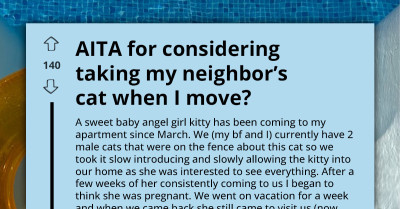Redditor Considers Blocking Their Cat’s Former Foster Carer Over Constant Check-In Messages, Years After Adopting The Kitty
Cats are understandably one of the pets with the highest number of owners worldwide. Who doesn’t like their fluffy fur and adorable eyes? Certainly not us!
These felines are one of the best pets to have around because of their low-maintenance nature. Cats are also independent and can help keep their owner’s home pest free, as they’re natural insect killers. More than all these, their long life span makes them a favorite for many.
With all their great qualities, it’s easy to understand why people get attached to them and find it difficult to let them go or get over them.
We found one story on the AITA subreddit that tells a similar story.
OP shared that they had adopted a cat from a foster organization in 2016. Before then, a lady had cared for the cat and nursed it back to health after some traumatic injuries.
The lady had told OP that she liked to check in on the cats she’d previously fostered via social media. True to her words, during the first year, she sent several messages checking in on the cat.
OP was initially eager to respond to the messages. However, this stopped when the lady’s message continued over the years, and OP stopped responding often.
In 2020, the lady reached out again, and this was the last straw for OP, so they reported to the agency, and the agency assured OP that they would ask her to stop. According to OP, the messages stopped.
However, on OP’s Cat’s birthday, the lady reached out again, and OP considered blocking her. This made them wonder if blocking her would make them the AH.
Scroll down to see the community’s verdict!
Let's dig into the details

OP adopted their cat from a foster carer who had a habit of checking in from time to time to see how the cat is doing

4 years after the adoption OP continued to receive messages from the foster carer, which forced them to report her to the foster organization

The Role of Attachment in Fostering Relationships
When individuals adopt pets, they form significant emotional attachments, often reminiscent of human relationships.
Research in attachment theory emphasizes the importance of these bonds, which can lead to a desire for ongoing contact with the pet's previous caregivers.
This situation reflects the emotional complexity involved in fostering and adopting animals.
The Dynamics of Fostering and Letting Go
The relationship between foster carers and the pets they care for often involves deep emotional bonds. According to studies in attachment theory, fostering creates a unique dynamic where caregivers develop strong attachments to animals, which can complicate the process of letting go.
This emotional investment can lead to feelings of loss and anxiety when the time comes to relinquish the pet, highlighting the importance of processing these emotions.
The Dynamics of Post-Adoption Relationships with Fosters
Dr. Lisa Monroe, a psychologist specializing in animal behavior at the University of Chicago, discusses the emotional complexities that arise after adopting a pet from a foster situation.
When a pet owner maintains contact with the foster caregiver, it can lead to mixed emotions regarding attachment and boundaries.
This dynamic reflects broader psychological principles of attachment theory, where individuals may struggle with letting go of emotional connections.
Recently, OP received another message from the foster carer on their cat's birthday. Now they're contemplating blocking her to prevent any more messages in the future

We gathered some interesting reactions from the Reddit community:
"She's overstepping. I get that she probably cares about the kitty, but part of fostering is giving up the kitty."

"Foster parents sometimes get super attached to an animal they're caring for....Report her again to the foster agency."

From a psychological perspective, the former foster carer's constant check-ins may stem from a need for reassurance and connection.
Studies indicate that individuals involved in caregiving roles often struggle with letting go due to emotional ties formed during the caregiving process.
This can lead to ongoing feelings of attachment that are hard to relinquish.
Moreover, the constant check-ins from the foster carer may indicate unresolved feelings about the pet's departure. Behavioral psychologists suggest that maintaining contact can reflect a struggle to let go and a desire to ensure the pet is well-adjusted in its new home.
Understanding these emotional dynamics can aid in navigating this complex relationship.
Research in the Journal of Animal Ethics indicates that maintaining relationships with foster caregivers can be beneficial for both the pet and the adopter, as it allows for continued support and knowledge sharing.
However, over-communication or intrusive check-ins can lead to feelings of overwhelm and invasion of privacy, as seen in this case.
Recognizing these boundaries is essential for fostering a healthy post-adoption relationship.
"Yes, block her, and tell the organization she reached out to you again."

"Feel free to block her, she obviously continues to overstep boundaries that both you and the rescue has set!"

"You should feel free to block her if you would feel more comfortable not hearing from her again."

Balancing Boundaries and Emotional Needs
Establishing boundaries is crucial in maintaining healthy relationships, particularly in situations involving shared emotional attachments.
Research suggests that setting clear expectations for communication can help manage feelings of anxiety for both parties.
In this case, it would be beneficial for the adopter to communicate their needs regarding contact while expressing appreciation for the foster carer's involvement.
Setting Boundaries in Relationships
In situations where foster care is involved, establishing clear boundaries is essential. Dr. Alexandra Solomon, a relationship therapist, states, "Boundaries are the key to healthy relationships; they define what is acceptable and what is not." You can find more insights on her approach at dralexandrasolomon.com. Research shows that boundaries help define the nature of relationships and can reduce feelings of discomfort. When boundaries are unclear, it can lead to confusion and frustration, as seen in this case.
Establishing Healthy Boundaries
Effective communication is key when navigating the dynamics between adopters and foster caregivers.
Experts recommend that pet owners express their feelings regarding the frequency of check-ins, fostering an open dialogue about comfort levels.
Utilizing 'I' statements can help convey these feelings without placing blame, promoting a more constructive dialogue around boundaries.
"If she’s not able to let her fosters go mentally, she’s going to one day run into a family who will do more than block her"

"Ywbta. It's one message in three years. Your cat might not even be alive if not for people willing to foster it."

The commenters believe OP is NTA in this situation. In fact, some people are surprised that they have been able to cope this long without blocking the foster carer.
While the commenters understand that it may be difficult for the lady to let go of the cat, they believe she’s overstepping, especially since she’s going against the agency’s rules.
We'd love to get your thoughts on this story. Join the conversation in the comments below.
Additionally, engaging in active listening can enhance mutual understanding and empathy.
Research shows that individuals who practice active listening are better equipped to resolve conflicts and strengthen their emotional bonds.
This technique involves summarizing what the other person has said and responding with empathy, creating a safe environment for expressing feelings.
Finding Compromise and Building Trust
To navigate the complexities of post-adoption relationships, individuals should seek compromise that respects everyone's needs.
Establishing clear expectations around communication can foster collaboration and reduce feelings of overwhelm.
Studies show that when individuals work together toward a common understanding, it strengthens their bonds and builds trust.
Moreover, exploring the emotional significance of the relationship can lead to deeper insights for all parties involved.
Understanding why maintaining contact is important for the foster caregiver can foster empathy and compassion, allowing for more collaborative decision-making.
Research shows that acknowledging each other's feelings can enhance satisfaction and emotional intimacy.
Seeking Professional Guidance When Needed
If conflicts persist, seeking professional help can provide valuable support for individuals navigating these dynamics.
Therapists can facilitate discussions and help individuals express their feelings in a safe environment.
Research indicates that professional guidance can improve communication skills and strengthen interpersonal dynamics.
Additionally, engaging in educational resources about pet adoption and post-adoption relationships can empower individuals with knowledge and strategies.
Workshops, books, and online resources can offer practical insights that support healthy relationships and responsible pet ownership.
Investing time in learning can transform challenges into opportunities for growth and connection.
Psychological Analysis
This situation highlights the emotional dynamics at play in post-adoption relationships. Understanding the significance of these connections can help individuals approach the situation with empathy and a willingness to establish healthy boundaries.
Analysis generated by AI
Analysis & Alternative Approaches
In conclusion, navigating the complexities of post-adoption relationships requires effective communication and understanding of emotional needs. According to Dr. Tal Ben-Shahar, a happiness researcher, "Open dialogue is crucial for fostering trust and understanding in any relationship." By implementing strategies that promote compromise and emotional awareness, individuals can create harmonious environments that respect both human and animal needs. As noted by Dr. Susan David, an expert in emotional agility, "Recognizing and addressing emotional needs is essential for nurturing lasting connections."
To address this, it's important for the pet owner to communicate their needs clearly. Engaging in open conversations about expectations regarding contact after adoption can help foster a more comfortable relationship.
Setting these boundaries can help both parties navigate their feelings and create a more supportive environment.
The Importance of Emotional Closure
Emotional closure is vital for both foster carers and pet owners to transition healthily. Research shows that allowing time for processing emotions related to the pet's departure can facilitate healing and adjustment.
Therapists recommend engaging in reflective practices, such as journaling or discussing feelings with supportive friends, to help process these transitions.
Additionally, creating a memory book or keepsake can provide a tangible way to remember the pet while allowing the foster carer to let go. This process can help validate the emotional experience and foster a sense of closure.
Ultimately, recognizing the emotional significance of fostering can lead to healthier relationships between all parties involved.
Psychological Analysis
This situation reflects the natural emotional attachment that develops during the fostering process. Encouraging clear communication and providing opportunities for emotional closure can help all parties navigate their feelings more effectively.
Analysis generated by AI
Analysis & Alternative Approaches
In summary, navigating the emotional complexities of fostering requires clear boundaries and opportunities for emotional closure. By fostering open communication and recognizing the feelings involved, both foster carers and pet owners can create a supportive environment.
Ultimately, honoring the emotional significance of these relationships can lead to healthier transitions.
Moreover, addressing the emotional implications of fostering is essential for both the foster carer and the adopter.
Psychologists recommend engaging in reflective practices to help both parties process their feelings and establish a mutual understanding.
Encouraging open discussions about feelings surrounding the cat can help both individuals find closure and define their new relationship.
Practical Steps for Healthy Communication
To navigate this situation effectively, the adopter should consider scheduling regular but limited check-ins.
This approach allows the former foster carer to maintain a connection without overwhelming the new owner.
Setting boundaries while honoring the emotional significance of the relationship can foster a more comfortable dynamic.
Psychological Analysis
This situation highlights the emotional intricacies of fostering animals and the challenges involved in transitioning to new ownership.
Recognizing and addressing these feelings through respectful dialogue can lead to healthier dynamics for everyone involved.
Analysis generated by AI
Analysis & Alternative Approaches
In conclusion, navigating the emotional complexities of fostering and adopting pets requires sensitivity to the feelings of all involved.
By fostering open communication and establishing boundaries, both the adopter and the former foster carer can find a way to honor their emotional bonds while respecting each other's space.



